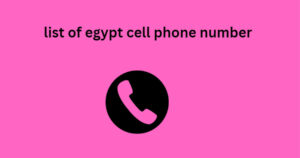One of the most important parts of any business is to offer reliable customer support. This means that when a customer calls your business, you are always reachable and can provide quick and effective service. Offering such a support channel can prove difficult at times, especially when your team does not have the right business phone system tools. Fortunately, advanced services such as call forwarding and phone system automation can support your call volume.
Use Call Forwarding to Implement Phone System Automation
5 Ways to Improve Call forwarding and phone list of egypt cell phone number system automation can work hand-in-hand to help callers get the assistance they need. This means transferring calls automatically or through an automated response system to the right agent, voicemail, or pre-recorded messages. Doing so can help your business offer quick and accurate customer support. Here are 5 ways to use call forwarding and phone system automation to improve your call flow management.
1. Interactive Voice Response
5 Ways to Improve A cloud-hosted IVR system or interactive voice response is an automated phone system that answers incoming calls, identifies the purpose of the call, and proceeds to assist how to know if someone viewed you on telegram the caller. Your IVR system can present options to the caller through a series of menus such as “Press 1 for sales, Press 2 for customer support, Press 5 to make a payment, Press 4 for voicemail, and so on.” This way, callers can input the service they need.
2. Name or Company Directory
This feature is part of your automated phone system it cell number where you create a name or company directory so that callers can navigate by themselves to the department they want such as “Press 1 for marketing.” Having the automated system present customers with options means that they don’t have to know the department’s number or dial an extension themselves. You can list specific departments or even specific employees with an automated phone system. This also reduces the amount of transferring a caller has to go through before they reach the right department or employee.
3. Advanced Routing Strategies
An automated phone system will give you the opportunity to use various call forwarding and routing strategies for maximum productivity. For example, calls made during off-hours or weekends can be routed to remote employees who have an evening or weekend shift. This is called time-based routing. You may even forward those calls to your own smartphone or home office.
Or, you can have certain calls forwarded to remote employees or international offices located in different parts of the world with location-based routing. This type of automation is especially useful for companies with international reach and clientele. Lastly, you can have incoming calls ring on multiple devices at the same time. This ensures that the call is answered quickly and no call goes missed.
4. Multichannel Communication Options
Offering support only through phone conversations may be a disadvantage. Especially considering most customers look for emails, chat, or social media contact methods. This is why your business should consider using human collaboration with phone system automation. For instance, chatbots can help resolve issues through pre-recorded messages and rules. Automated responses inform customers that your business has received their message and will respond within a few days.

